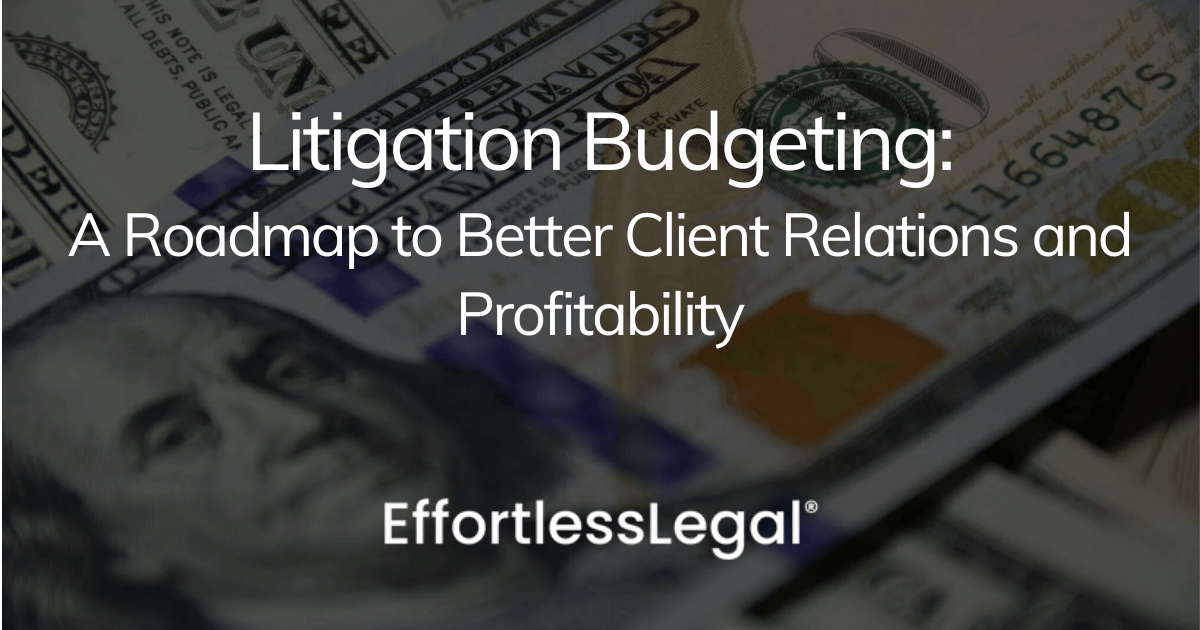Litigation Budgeting—A Roadmap to Better Client Relations and Profitability

A recent law firm management article noted that lawyers are “reluctant to provide litigation budgets because litigation is unpredictable and accurate budgets are difficult to prepare.” Despite this obvious and critical shortcoming, litigation budgets are far from useless. And corporate clients almost universally require litigation budgets.
According to a recent Altman Weil survey of legal departments, 46.2% of the 280 responding in-house legal departments listed improved budget forecasting as one of the top service improvements they wanted to see from law firms. Similarly, a different survey of law firms found that 85% of law firms are “proactively initiating” budgeting conversations with their clients to better understand expectations.
In fact, properly implemented litigation budgeting practices can lead to significant improvements in client relations and law firm profitability.
Litigation Budgeting
At the onset of a legal matter, lawyers have a general idea of what the litigation process will entail. Cross-referencing the expected amount of work with the relevant attorney and paralegal billing rates is the essence of litigation budgeting.
The initial budget estimate serves the two main purposes of forecasting the client’s financial responsibilities, and creating a written plan of what the litigation process is going to entail. Ideally, this estimate would serve as a roadmap of the pleadings and related motion practice anticipated, discovery and depositions that will likely be required, summary judgment possibilities, trial estimates, and of course an approximation of billable time to complete the various tasks and activities involved.
All the same, lawyers are not clairvoyant. Any number of things can greatly protract or truncate the actual amount spent on a matter. For example, counterclaims, unexpected dismissals, obstreperous opposing counsel, and various other eventualities make accurately predicting the costs of litigation problematic.
These valid concerns about accuracy can cause attorneys to see litigation budgets as a waste of time, or draft initial budget estimates as if they were nothing more than a client appeasement measure. For example, a recent article in the Corporate Counsel Business recounts that outside counsel will often simply “over-estimate the projected figures to protect his or her fees. This only pushes the budget further away from a true planning tool toward a fee protective device. In such cases, not only is the budget ‘just a number,’ it is an artificially high number at that.”
Treating budgeting merely as a perfunctory task serves no one. Moreover, this mindset fails to take into account the logistical and strategic value of a well-reasoned plan of events.
Litigation Budgeting as a Management Tool
Making sure that outside and in-house counsel are on the same page will save everyone a considerable amount of grief. Crafting a detailed and informed litigation budget helps to manage expectations and give both attorney and client the opportunity to make sure that their projections (both in terms of action and money) are in sync.
Similar to the billing process, the level of detail can make or break a litigation budget. According to legal spend management firm Quovant, if all interested parties have access to a detailed litigation budget, it should negate contention over scope and provide the opportunity for realignment well in advance.
Fluid Litigation Budgeting
Valuable information from prior matters can be mined for future matters. Each matter should serve to increase the accuracy of the budget for the next matter.
However, there’s no reason not to maximize efficiency on the current matter as well.
In fact, one of the best ways to maximize the utility of a litigation budget is to implement milestones or thresholds. When a preset percentage of the budget is reached, all parties come together to re-evaluate. This re-evaluation can potentially revise both financial and outcome expectations.
Keeping track of spend in this manner is more proactive than simply providing an estimate in the beginning of litigation, and then not returning to subject as facts unfold. At the same time, adjusting the budget after services already exceed the budget is equally less than ideal and an easy way to aggravate clients.
Real Time Budget Monitoring
Another valuable solution is to monitor and control legal expenditures in real time.
Administrative or other personnel often track accumulated hours and expenses during each billing month, in order to notify attorneys when the total expenditures are approaching budgetary limits. In fact, several large law firms developed their own proprietary software for exactly this purpose, and tout successes in their use.
Whether by manual or automated approaches, monitoring budgets in real time allowed lawyers and their clients to be quickly informed when a budget may be due for reconsideration. Such “hands-on” approaches allow for fewer surprises and better client communication.
As a financial forecasting tool, litigation budgets are far from perfect. However, as a litigation management and client relations tool, litigation budgets can be a great asset to clients and law firms alike.
It’s obviously impossible to predict everything that could happen along the way. But having an agreed upon roadmap helps ensure everyone is on the same page about the direction of the litigation. These factors lead to more transparent billing which can promote improved realization and collection rates.



